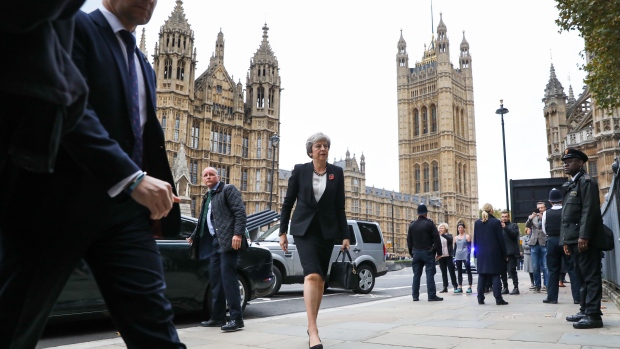Nov 13, 2018
Breaking down Brexit: A guide to the home stretch
, Bloomberg News

The U.K. and European Union negotiators have reached a draft Brexit deal, according to a person familiar with the situation. But it’s far from over yet.
Here are the things to know as we head into the home stretch.
1. What’s the deal?
It will be the most important international agreement in Britain’s postwar history. It will set out the terms of separation that allow the U.K. to depart the European Union on March 29, 2019 in an orderly fashion -- and bring with it a grace period to give everyone time to adjust. It will probably also come with a political declaration that sets out how the two sides want to trade in the future -- but the details of a free-trade agreement could take years to work out.
Prime Minister Theresa May has to get her Cabinet to sign off on it at an emergency meeting called for Wednesday. They will be briefed Tuesday, need to digest hundreds of pages of dense legal text and then asked to support it. But their backing is not a given.
2. So it’s too soon to celebrate then?
Yes and no. For months, negotiations have been at impasse over what’s become known as the Irish backstop. It’s complicated and you can read why it’s been such a sticking point here. The most difficult section of the agreement is the bit dealing with this issue. Pro-Brexit ministers will be worried whether it traps the U.K. in the customs union indefinitely.
So getting the Cabinet on board is one hurdle. Assuming she jumps it, a special EU summit could come end of the month to get all leaders to give it their rubber stamp. The problems, as always, are back home.
She would still need to get it past Parliament, where the government doesn’t have a majority and faces opposition on all sides. This historic decision is going to hang on just a handful of votes. The biggest risk comes from about 50 furious pro-Brexit Tory lawmakers who think she’s caved to the EU and betrayed the electorate’s call to regain sovereignty. There is also the danger that the 10 Northern Irish lawmakers propping up her government could shoot the deal down if they feel it treats the region differently to the rest of the U.K. Some pro-EU Tories aren’t very pleased either. With the numbers this tight, May’s whips are fishing for support in the opposition Labour Party while turning the screws on their own.
3. Would losing be that bad?
Depends who you ask. If Parliament rejects it, Labour will push for a general election. But the chaos that ensues would probably also provide the best chance for lawmakers to push for a second referendum. A group of members of Parliament from across the House of Commons are trying to engineer a re-run but so far there’s nowhere near a majority for it.
There’s a real chance that if the deal is voted down, the country will crash out of the bloc into a legal limbo that would snarl trade and freeze up markets. Free trade between Britain and the EU will give way to basic World Trade Organization tariffs and become subject to border checks. Delays would be so bad that the government has plans to turn a major highway near the Port of Dover into a holding zone for trucks. Bottlenecks could bring shortages of everything from food to drugs and manufacturing components. Financial contracts would also risk being void and there’s a question mark over how derivative trades would be cleared.
4. How does the City emerge from this?
The deal -- once it’s through Parliament -- brings some relief to London’s financial hub because the grace period buys them time. But because of the way the talks were structured, there’s still not much clarity about how banks will operate in the future. What is known is that there’s a big downgrade from the status quo. That’s to be expected as the U.K. had long dropped demands for close integration. U.K. banks will have to use the same or similar regime to the one U.S. and Japanese banks use now -- it’s called equivalence and it has lots of pitfalls. The full extent of the changes will emerge in the final trade agreement, which could be years from now.







